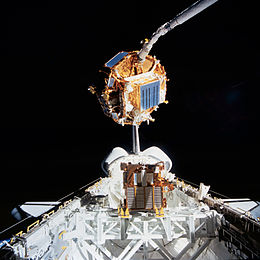


| |
| Mission type | Technology |
|---|---|
| Operator | NASDA ISAS NEDO USEF |
| COSPAR ID | 1995-011A |
| SATCAT no. | 23521 |
| Website | www |
| Mission duration | 10 months |
| Spacecraft properties | |
| Manufacturer | Mitsubishi Electric |
| Launch mass | 3,846 kilograms (8,479 lb) |
| Landing mass | 3,492 kilograms (7,699 lb) |
| Start of mission | |
| Launch date | 18 March 1995, 08:01 (1995-03-18UTC08:01Z) UTC |
| Rocket | H-II 3F |
| Launch site | Tanegashima Yoshinobu 1 |
| End of mission | |
| Recovered by | Space Shuttle Endeavour STS-72 |
| Recovery date | 13 January 1996 (1996-01-14) |
| Landing date | 20 January 1996, 07:41:41 UTC |
| Landing site | Kennedy SLF Runway 15 |
| Orbital parameters | |
| Reference system | Geocentric |
| Regime | Low Earth |
| Perigee altitude | 470 kilometres (290 mi) |
| Apogee altitude | 492 kilometres (306 mi) |
| Inclination | 28.4 degrees |
| Period | 94.22 minutes |
| Epoch | 17 April 1995[1] |

The Space Flyer Unit (宇宙実験・観測フリーフライヤ, Uchū Jikken-Kansoku Free Flyer) was a spacecraft which was launched by Japan on March 18, 1995.[2]

The Space Flyer Unit was launched from Tanegashima Space Center from a H-II vehicle.[2] It carried testing materials and research data that held value to NASA. The crew of STS-72 aboard Space Shuttle Endeavour retrieved the satellite on January 20, 1996, 10 months after it was launched.[2] The idea behind the implementation of the SFU was a joint effort by multiple major corporations and government agencies. The ones that were involved with the launch were Institute of Space and Astronautical Science, the National Space Development Agency, and Ministry of International Trade and Industry.[3]
After the shuttle returned the SFU from space it was transported to Japan and refurbished for display at the National Museum of Nature and Science in Tokyo.[4]
The original purposes behind the SFU were to[5]
A variety of systems that were operational within the SFU had never been implemented before. Equipment on board supported an infrared telescope, two-dimensional solar array, high voltage solar array, space plasma diagnosis, electric propulsion, material experimentation, gas dynamics, gradient heating chemicals, isothermal heating furnace and more.[6] The core system that was built into the SFU contained an octagonal aluminum truss. Inside of that were eight boxes of trapezoidal shape.[6] The SFU was connected directly to the Kagoshima Space Center.[7]
There were a number of various types of experiments that were performed on board the SFU during its launch life cycle. Those experiments, and light data related to them are listed below.
|
| |||||||||||||||||||||
|---|---|---|---|---|---|---|---|---|---|---|---|---|---|---|---|---|---|---|---|---|---|
| |||||||||||||||||||||
| |||||||||||||||||||||
| |||||||||||||||||||||
| |||||||||||||||||||||
| |||||||||||||||||||||
| |||||||||||||||||||||
| |||||||||||||||||||||
| |||||||||||||||||||||
| |||||||||||||||||||||
| |||||||||||||||||||||
|
| |
|---|---|
| January |
|
| February |
|
| March |
|
| April |
|
| May |
|
| June |
|
| July |
|
| August |
|
| September |
|
| October |
|
| November |
|
| December |
|
Launches are separated by dots ( • ), payloads by commas ( , ), multiple names for the same satellite by slashes ( / ). | |